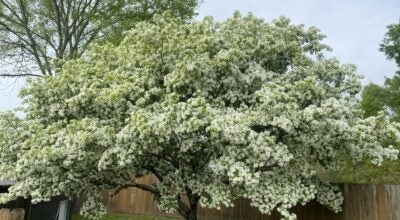Lichens on trees and shrubs not harmful to host plants
Published 12:17 am Sunday, October 6, 2013
Lichens are unique organisms that can be found growing on a wide variety of surfaces including bark on trees, open soil and bare rock. If you have spent any time in the outdoors, more than likely you have seen lichens. These organisms are unique in that the lichen is not composed of a single organism. In actuality, the lichen is comprised of two radically different organisms.
Lichens are a combination of a fungus and a photosynthetic organism, such as a green algae or cyanobacterium. The fungi provide the structure to house the photosynthetic organisms, and the structure allows for the collection of water and nutrients, which are required to sustain the photosynthetic organisms. In return, the photosynthetic organisms synthesize carbohydrates (sugars) through photosynthesis, and the carbohydrates are shared with the fungi for energy because the fungi do not have the ability to photosynthesize on their own. The association of these two organisms is considered to be a symbiotic relationship because both organisms benefit from the association.
Lichens are quite diverse. There are reportedly more than 15,000 different lichens in existance. Lichens can assume different forms with many different colors, and can be categorized in three basic body forms according to their appearance. Crustose is a form that looks like a powder over the surface, and it is commonly referred to as crust-like. Foliose is another form of lichen, which has a folded leaf appearance, and fruticose is a form that produces a highly branched structure with hair-like projections. The majority of lichens are grey to green in color, but the colors can range from yellow, orange, red, and brown.
As previously mentioned, lichens can be found on a wide variety of surfaces including the bark on trees and shrubs. Although the lichens persist on plants, they are not considered to be harmful to plants. Lichens do not penetrate the bark tissue and extract plant sap like parasitic organisms, such as mistletoe, do. This is evident because lichens colonize nonliving structures, such as rocks. The lichens utilize the trunks and limbs of trees and shrubs as a surface to colonize in order to be exposed to sunlight. Lichens become prevalent on plants growing in full sun conditions, and particularly on plants that have thinned or weakened canopies that allow substantial amounts of light to penetrate the canopy. A weakened canopy is common in situations where the integrity of the plant has been compromised by some other factor, such as a disease pathogen or unfavorable conditions. Frequently, people make the assumption that lichens are pathogenic and cause harm to their plants because they are prevalent on plants that are in decline, but in actuality, the lichens are present as a result of a weakened canopy.
Control of lichens is not recommended because they are not disease pathogens. However, the presence of lichens, particularly on ornamentals, can be aesthetically disruptive and unattractive. In order to reduce the presence of lichens, maintaining healthy plants with vigorous growth is recommended. Maintaining proper soil fertility and irrigation practices can lead to the development of a denser leaf canopy and reduced light penetration into the canopy, therefore reducing the presence of lichens.
Although the lichens can be aesthetically unattractive, they can be considered a good sign in relation to environmental conditions. Lichens are considered to be biological indicators for air quality because they are very sensitive to air pollutants. Since lichens are unable to excrete toxic substances that are absorbed from the air, they can’t persist when the air contains toxic substances, and subsequently perish.
This article was compiled by Scotty May, Assistant Extension Agent (ANR) for Washington Parish. For more information concerning this article or related topics, please contact the Washington Parish Extension Office at 839-7855.





